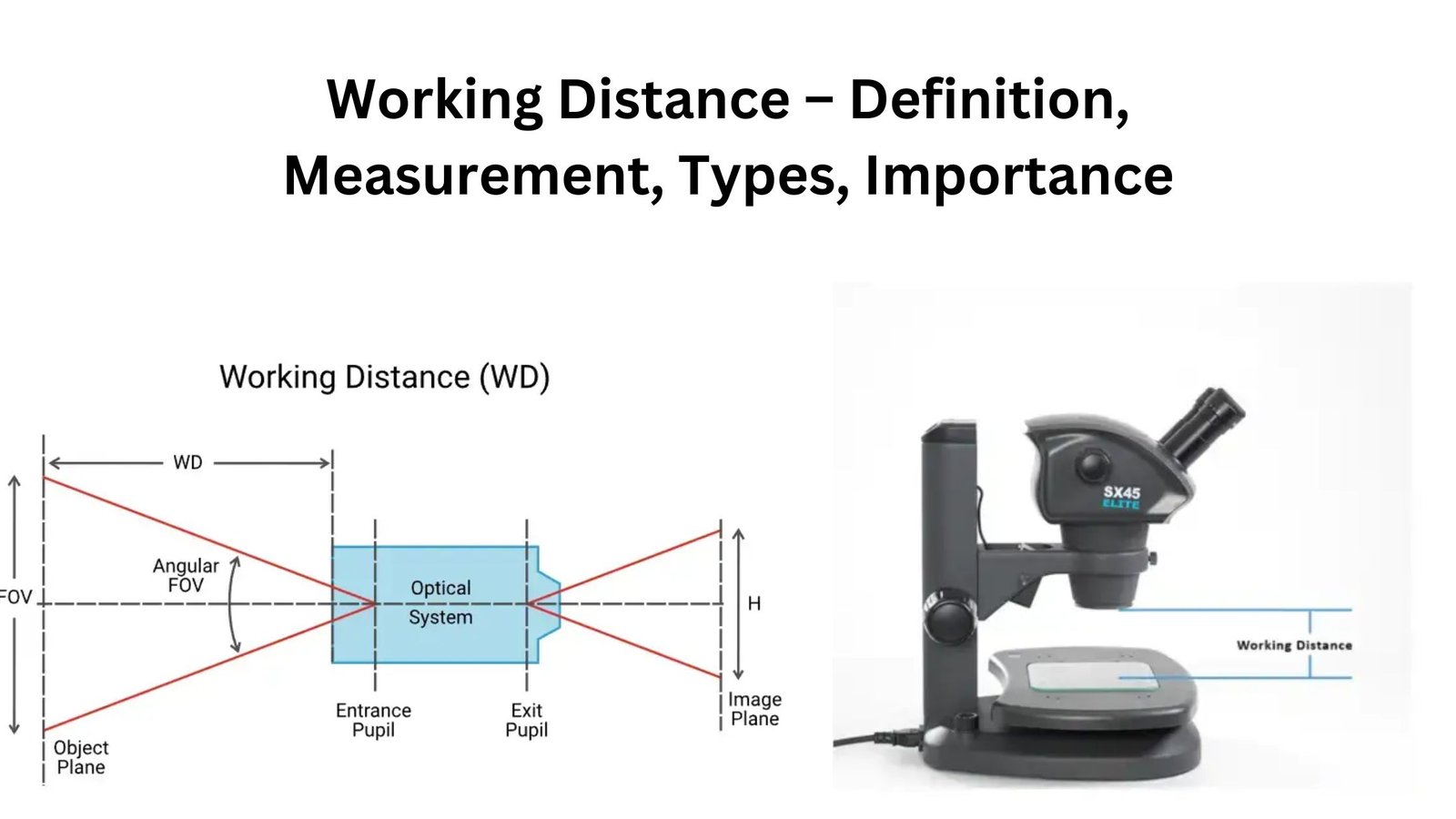What is Working Distance?
In optics and microscopy, working distance—a fundamental idea—is the empty space between the object of view and the front surface of the lens or lenses in a microscope. Measuring in millimetres (mm), this distance greatly influences our perspective of objects under microscopes.
Consider yourself examining little items under a microscope. Between the lens and the object, the working distance functions as the “breathing room.” It’s crucial as it controls the object’s distance from the lens while nevertheless maintaining focus’s accuracy. The range runs from the moment the item is closest to the lens until it looks to be rather far away.
Fascinatingly, the operating distance of the microscope increases less as you raise the magnification to view objects closer. It’s like zooming in on a picture: the less space there between the lens and the item the closer you zoom in. This is thus because increased magnification requires certain lenses with larger “eye openings,” which lowers the distance they can operate with efficiently.
These lenses are painstakingly designed by manufacturers. They look for a mix between ensuring they can still focus correctly even when the item is not exactly up close and making the lenses strong so you can see little objects.
Working distance is not the same as another word used, “front focal distance,” which gauges the distance from the lens’s front surface. In stereo microscopes, some people also define working distance differently, maybe from the base of the microscope or the lowest optic.
Most importantly, though, is the distance separating the lens from the item you are examining. It resembles the gap between the lens and the slide in a stereo microscope. That is the point when the thing appears to be rather crisp and distinct.
Here’s a fun tip: you have seen the value of working distance if you have ever unintentionally banged a microscope lens against a slide and felt relief that it did not break. Much depends on the distance separating the slide from the lens.
Simply said, therefore, working distance is the difference between your lens and what you are viewing. It influences your clarity of vision, particularly in relation to a significant magnification. Though they magnify the same, various lenses have varying working distances. Knowing working distance can help you select the correct lens for your travels throughout a microscope.
What is working distance in Microscope?
When talking about microscope, the word “working distance” has more than one meaning. Some experts say it refers to the space between the base of the microscope and the thing you’re looking at. Some say it has to do with the distance from the lowest lens’s surface or a similar point of reference. No matter the point of view, the important thing is still the space between the lens and the point where the subject becomes clear.
It’s important to keep this separate from the place under the stereo microscope, which also needs to be big enough for the thing being studied. The working distance stays the same, but the position of the microscope can be changed vertically to make it easier to place objects correctly.
If everything went perfectly, these little details might not matter, and there would always be plenty of room to try new things. But in the real world, physics rules apply, especially when it comes to how in-focus zoom and distance from the lens affect each other.
In order to change the working distance of a stereo microscope, the objective lens must also be changed. These lenses are at the end of the microscope that faces the object being studied. They can be used to make things bigger or smaller. They change not only the resolution but also the distance at which you can work.
If you choose a higher-power objective lens, the total magnification will be higher, but the working distance will be shorter. On the other hand, adding a lowering objective lens lowers the total magnification and increases the working distance. Researchers and microscopy fans can change the way they use microscopes to fit their needs thanks to the way objective lenses and working distance change over time.
The working distance in microscopy is the space between the objective lens of a microscope and the point where it is focused perfectly on a subject. It is a complicated measure that is affected by objective lenses, magnification, and practical concerns. These factors all add to the art and science of studying tiny objects.
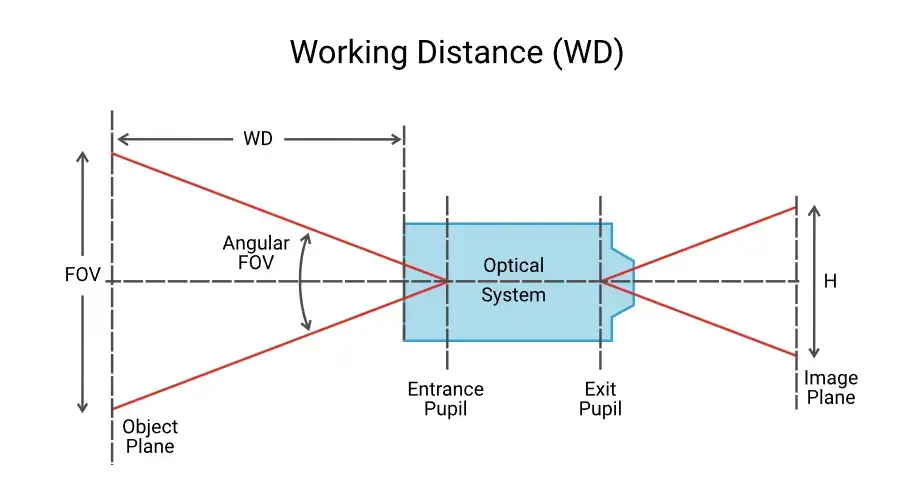
What Are the Different Types of Working Distances in a Microscope?
Microscope working distances fall into two categories:
- Objective Working Distance: The distance between the optical instrument’s front lens and the object’s nearest component. The space you have to deal with to place the thing beneath the lens and make it visible. Measurements sometimes include the slide cover.
- Stage Working Distance: You may see this space when moving the microscope’s tube, arm, or stage. This determines how thick or huge an object may be while still being visible at the goal working distance. Longer distances are preferable for viewing bigger items.
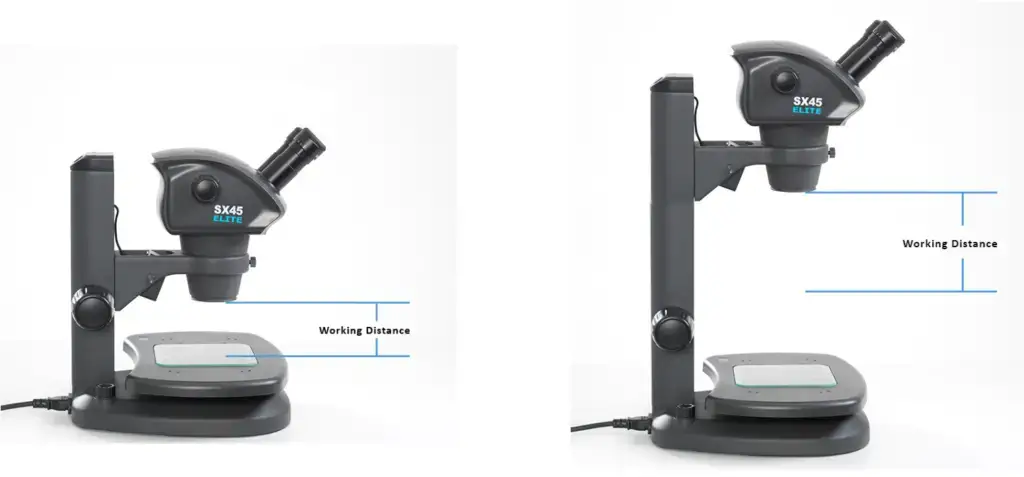
How Does It Work?
- It’s important to know how a microscope works, especially when looking at different things. It is very important to keep the right spacing between the microscope and the thing you want to look at. You need to move the lens farther away from some things because they might be dangerous or not flat.
- This is a useful measurement for microscopes when you need more room between the lens and the thing you want to look at. Things tend to get closer when you zoom in a lot, making the working space shorter. The working distance gets shorter as the zoom level goes up, though.
- Use different glasses to change the distance you can work at. The part of the microscope that looks at the item has these lenses on it. They can zoom in or out, and they can also change how far away the lens needs to be.
- When you put on a magnifying lens, the item appears larger, but you must approach it closer. And if you put on a lens that makes things look smaller, you can be farther away from the thing that is smaller.
- Working distance might be 50 millimetres (your thumb) or 0.1 millimetres. The working distance shrinks as you zoom in and make things clearer.
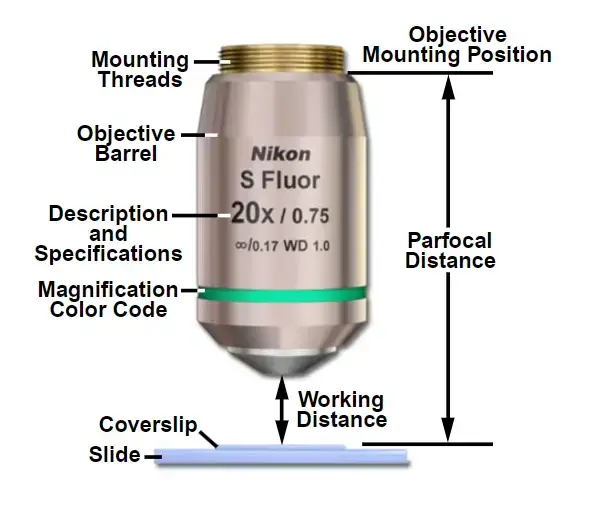
How to Find the Working Distance for an Objective Lens
Effective usage of a microscope and correct focus depend on knowing the working distance (WD) for an objective lens. Under sharp focus, the working distance—that is, the area between the objective lens and the specimen—is basically constant. The type of objective lens you are using can greatly affect this distance; knowledge of this will help avoid harm to your sample as well as the lens.
- Review the Specifications– Referring to the specs of the objective lens or microscope can help one determine the working distance the easiest. Usually found on the side or identified in the accompanying literature, objective lenses have their WD printed there. Usually expressed in millimetres (mm), this information will save you time and conjecture if you know this.
- Refer to the Magnification Chart; generally, shorter working distances correspond to higher magnitudes, say 100x or 200x. You can therefore approximatively determine the working distance knowing the magnification. A 4x objective lens might have a working distance of about 20 mm, for instance, whereas a 100x objective lens might have a WD as little as 0.2 mm. This will enable you to estimate the required space for handling particular lenses.
- Measuring Directly: Should the WD not be found in the specs, a quick fix is to measure it yourself. Starting with the objective lens above a cover slip or flat surface, gently pull it down under view through the eyepiece. Once you have focus, find the distance separating the lens from the specimen using a ruler or measuring calliper. Though it will get you an exact measurement for that particular objective lens, it is a little more laborious.
- Knowledge of the several kinds of objective lenses is important. Usually, a compound lens with high magnification will have a shorter working distance than an objective with lesser magnification. This is so because more exact lens placement closer to the sample is needed for higher magnification.
- Working distance of an objective lens depends also on its numerical aperture (NA) influence. Higher NA lenses might show a shorter WD. This is so because these lenses’ enhanced light-gathering capacity lets them operate more effectively but within a limited distance.
- Sometimes the fine focus mechanism of your microscope could also influence the working distance of your microscope. Should you find that changing the fine focus alters the apparent working distance, it is crucial to strike the ideal balance between object position and clarity.
- The Value of WD: Remember that handling specimens or using immersion oils can make a quite short working distance challenging. It can make it more difficult to view your sample correctly or unintentionally cause the lens to come into touch with the specimen. Conversely, a longer working distance might give more room to move your sample, but it might not deliver the clarity of the greater magnificiencies.
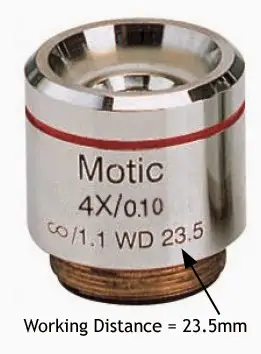
Importance of Working Distance in Microscope
- Depth of field – The working distance directly impacts how much of your sample remains in focus at once, where longer distances generally provide better depth perception whilst viewing specimens.
- Image Resolution— A shorter working distance typically yields higher resolution images, as it allows the objective lens to capture more detail from the specimen being observed.
- Safety considerations – Maintaining proper working distance helps protect both the specimen and expensive microscope components from accidental damage during focus adjustments.
- Stereo microscopes– These microscopes need longer working distances compared to compound scopes, as they’re frequently used to examine larger specimens and require space for manipulation.
- Illumination requirements – Like most microscopes, proper lighting becomes crucial at different working distances, where shorter distances may need specialized lighting solutions whilst longer ones offer more flexibility.
- Sample manipulation– The working space between objective and specimen determines how easily you can handle, adjust or modify samples during observation.
- Objective lens specifications— Different magnification levels require varying working distances, where high-power objectives typically have shorter distances compared to low-power ones.
- Environmental factors – Temperature changes and vibrations can affect the working distance, requiring careful consideration during prolonged observations.
- practical applications– Industries such as electronics and material science rely heavily on specific working distances for quality control and research purposes.
- specimen thickness– The working distance must accommodate samples of varying depths, especially when examining thick or three-dimensional specimens.
- Ergonomics – proper working distance contributes significantly to user comfort during extended microscopy sessions, helping reduce eye and neck strain.
- Focus stability– maintaining consistent working distance throughout observations ensures stable focus and reliable imaging results.
- accessory compatibility— The available working space determines which additional tools and accessories can be used with the microscope setup.
- calibration requirements– Regular checking and adjustment of working distance helps maintain accurate measurements and consistent imaging quality.
- https://www.visioneng.us/resources/articles/working-distance-a-simple-explanation/
- https://opticsmag.com/what-is-working-distance-in-a-microscope/
- https://microscopeclarity.com/what-is-working-distance/
- https://www.e-education.psu.edu/mcl-optpro/theory/node801
- https://www.olympus-ims.com/en/microscope/terms/working_distance/
- https://www.rp-photonics.com/working_distance.html
- https://blog.microscopeworld.com/2014/08/microscope-working-distance.html
- https://www.celestron.com/blogs/knowledgebase/what-is-the-working-distance-of-my-microscope
- https://pages.mtu.edu/~shene/DigiCam/User-Guide/Close-Up/BASICS/Working-Dist.html
- https://www.vision-doctor.com/en/optical-calculations/calculation-working-distance.html
- https://sciencing.com/difference-between-compound-dissecting-microscopes-5576645.html
- https://www.meetoptics.com/academy/working-distance
- https://www.newport.com/f/long-working-distance-objectives
